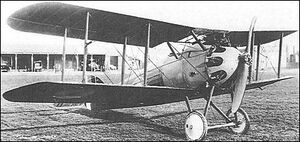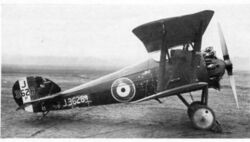Engineering:Sopwith Dragon
| Sopwith Dragon | |
|---|---|

| |
| Prototype E7990 at Brooklands Airfield | |
| Role | Fighter |
| Manufacturer | Sopwith Aviation Company |
| First flight | 1918 |
| Primary user | Royal Air Force |
| Number built | 200 |
| Developed from | Sopwith Snipe |
The Sopwith Dragon was a British single-seat fighter biplane developed from the Sopwith Snipe.
Design and development
In April 1918, the sixth Snipe prototype was fitted with a 320 hp (239 kW) ABC Dragonfly I radial engine.[1][2] To compensate for the greater weight of the Dragonfly, the fuselage was lengthened by 22 in (56 cm).[3]
The prototype suffered persistent ignition system defects, but performance was encouraging when the Dragonfly engine operated properly.[3][4] In June 1918, the Royal Air Force issued a contract for 30 Dragonfly-engined Snipes, which were subsequently named Dragons.[3][4] In late November 1918, the RAF cancelled a production order for 300 Snipes and reordered the aircraft as Dragons.[1]
A second prototype was equipped with the larger 360 hp (268 kW) ABC Dragonfly IA engine.[1] This aircraft did not begin official trials at Martlesham Heath until February 1919.[4] It attained a top speed of 150 mph (240 km/h) at sea level and achieved a service ceiling of 25,000 ft.[1]
Sopwith built approximately 200 Dragon airframes, which were placed in storage pending delivery of their engines.[1] Difficulties with the Dragonfly ultimately proved impossible to resolve. Only a few aircraft were completed with Dragonfly engines, and none were issued to squadrons.[1] The Dragon was finally declared obsolete in April 1923.[5]
Operators
 United Kingdom
United Kingdom
Specifications
Data from War Planes of the First World War: Volume Three Fighters[6]
General characteristics
- Crew: 1
- Length: 21 ft 9 in (6.63 m)
- Wingspan: 31 ft 1 in (9.47 m)
- Height: 9 ft 6 in (2.9 m)
- Wing area: 271 sq ft (25.2 m2)
- Gross weight: 2,132 lb (967 kg)
- Powerplant: 1 × ABC Dragonfly IA radial engine , 360 hp (268 kW)
Performance
- Maximum speed: 150 mph (240 km/h, 130 kn)
- Service ceiling: 25,000 ft (7,600 m)
Armament
- 2 × forward firing Vickers machine-guns
See also
Related development
Related lists
- List of aircraft of the Royal Air Force
Notes
References
- Bruce, J. M. War Planes of the First World War: Volume Three, Fighters. London: Macdonald, 1969. ISBN:0-356-01490-8.
- Davis, Mick. Sopwith Aircraft. Ramsbury, Marlborough, Wiltshire: Crowood Press, 1999. ISBN:1-86126-217-5.
- Mason, Francis K. The British Fighter Since 1912. Annapolis, Maryland: Naval Institute Press, 1992. ISBN:1-55750-082-7.
- Robertson, Bruce. Sopwith – The Man and His Aircraft. London: Harleyford, 1970. ISBN:0-900435-15-1.
 |


